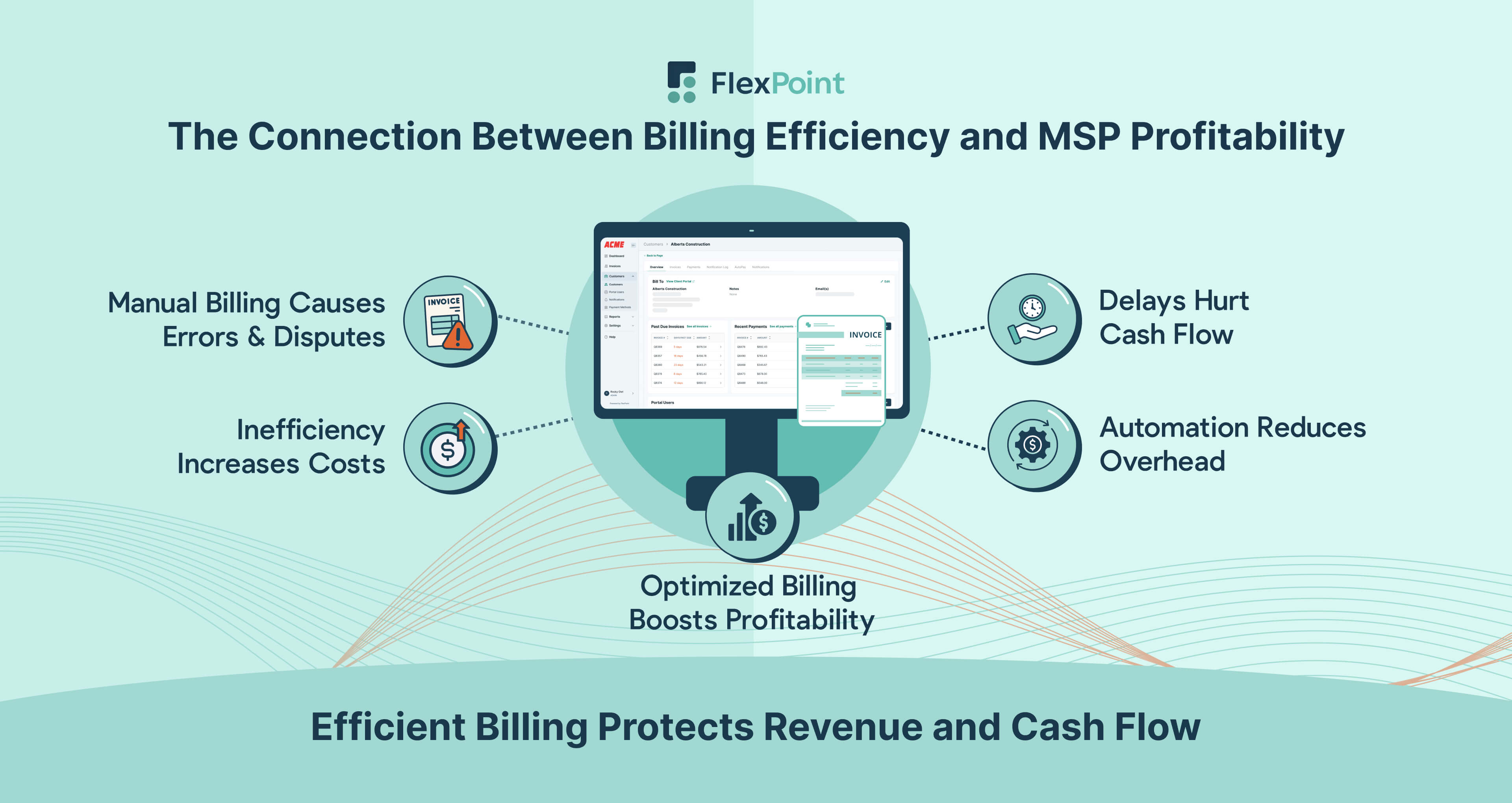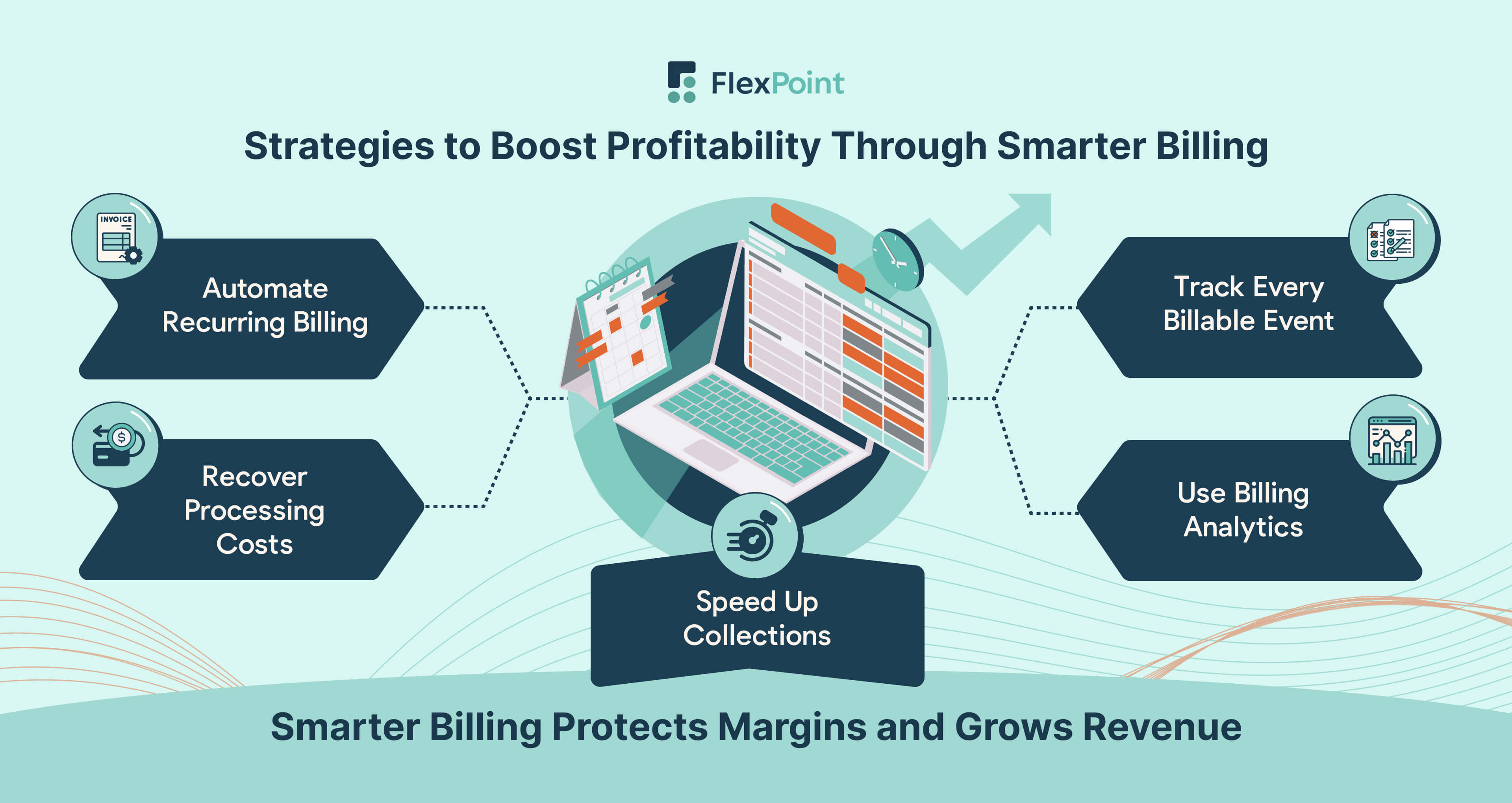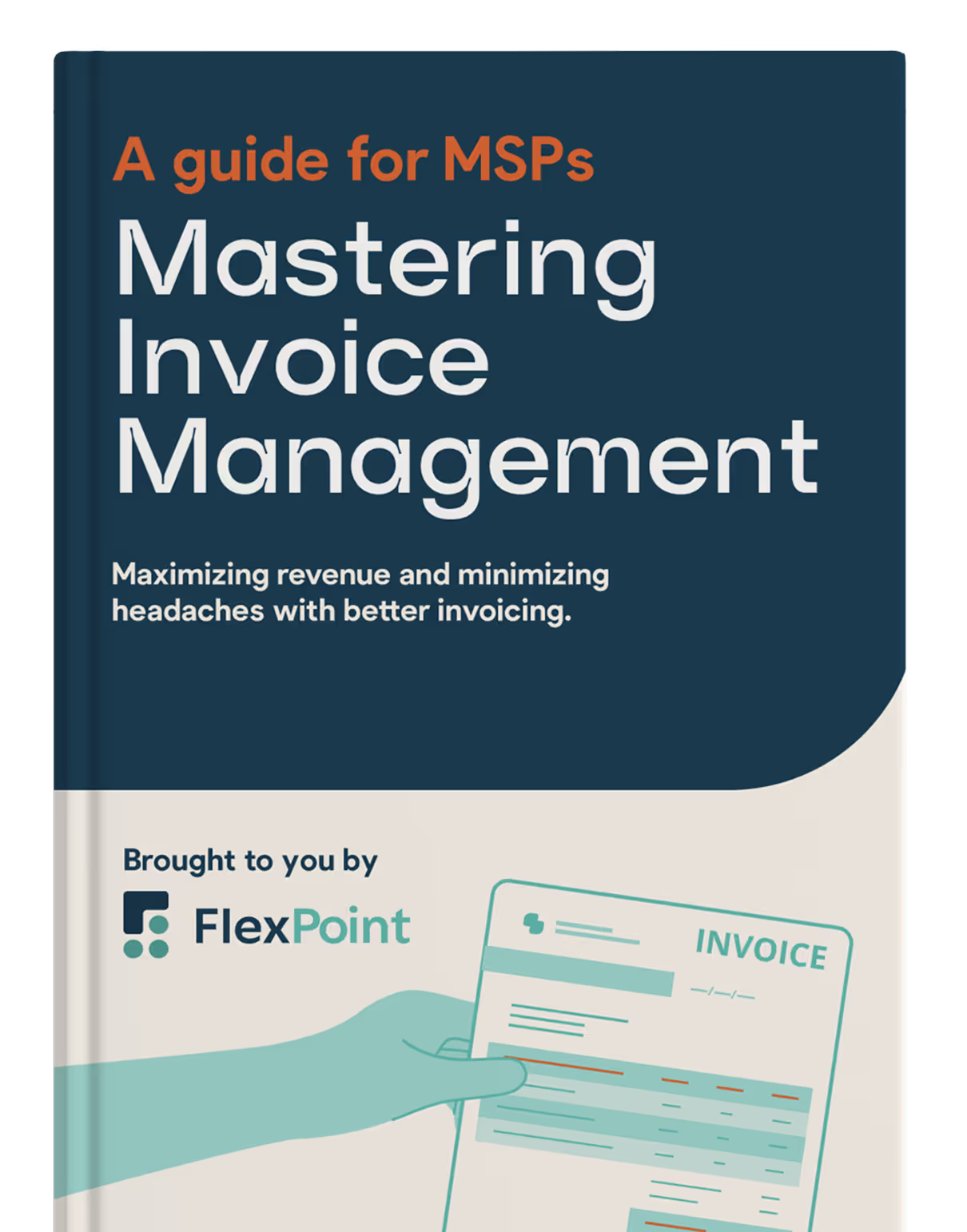How Smarter Billing Drives MSP Profitability

According to MSP insights, 70% of MSPs worry about profitability and face cash flow issues. MSP profitability depends on efficient billing and timely client payments.
Manual billing processes are often inefficient and prone to errors. Errors, such as underbilling or miscalculations, usually erode profits and lead to client payment disputes.
Smarter billing practices can drive long-term financial success. Automation, real-time tracking, and flexible payment methods can help Managed Service Providers (MSPs) streamline their billing processes and increase profitability. According to PYMNTS, companies with only 50% AR automation improve their cash flow by reducing their DSO (Days Sales Outstanding) by 32%.
Billing automation helps MSPs eliminate errors and ensure accurate invoicing. It also saves time by automatically generating invoices, freeing up resources and reducing costs. According to Ardent Partners, automation reduces the average time to process an invoice by 81%.
In this article, we will discuss effective billing strategies to enhance your MSP's profitability and explore how efficient billing processes can contribute to your business's growth.
{{toc}}
The Connection Between Billing Efficiency and MSP Profitability

Proactive and effective billing has a direct impact on your MSP’s revenue collection, operating costs, and cash flow predictability. According to Flywire, payment processing lapses cost 4 to 5% of the monthly revenue of around 55% of companies surveyed.
Manual billing can lead to increased administrative overhead, revenue loss due to billing errors and payment disputes, and delayed payments.
MSPs offer a range of services with complex pricing models, including hourly rates, fixed fees, and value-based pricing. Without a reliable and robust system for tracking service usage in real time, tracking these variables becomes challenging, leading to billing errors and missed charges.
For instance, if billable services are not accurately tracked, you may undercharge clients, which will negatively impact your bottom line.
On the other hand, overcharging clients may lead to disputes, delayed payments, and strained relationships. According to ReturnGO, merchant (i.e., the MSP team) errors are the reason behind 20% to 40% of payment disputes.
Manual invoicing, payment follow-ups, and reconciliation consume a significant amount of time and resources. According to PYMNTS, manual payment processes take 67% longer to follow up and stretch DSO by 30%. It increases labor costs for your MSP and slows down cash flow.
Additionally, failed transactions due to outdated payment collection software lead to a fee of $12.10 per payment, a poor reputation, and customer dissatisfaction.
Outdated billing software may have integration issues, resulting in operational inefficiencies. It would not work seamlessly with your PSA (Professional Services Automation) software like ConnectWise, AutoTask, SuperOps, or HaloPSA and accounting tools (such as QuickBooks Online, QuickBooks Desktop, or Xero), which can lead to data discrepancies, duplicate entries, manual reconciliation efforts, and billing errors. These billing inconsistencies increase operational costs on invoice rectification and settling client disputes.
Inefficient billing makes it challenging to forecast revenue and collect payments on time. According to Upflow, recurring billing errors put 66% of unpaid invoices at risk of remaining unpaid. Missed revenue has a negative impact on cash flow and hinders business growth.
Optimized billing processes benefit MSPs by driving top-line growth and improving bottom-line margins. Automating invoicing and implementing advanced payment collection systems leads to error-free billing and enhanced revenue collection.
Additionally, optimized billing processes enable MSPs to scale operations without proportionally increasing overhead in invoice generation, payment collection, and account reconciliation.
{{ebook-cta}}
5 Strategies and Best Practices to Boost Profitability Through Smarter Billing

According to MSP360, MSPs operate on thin margins ranging from 8 to 18%. To build a resilient financial foundation as an MSP, you must capture every dollar of revenue and trim administrative overheads.
In a competitive market with tight margins, even minor improvements in billing accuracy and timing can result in substantial increases in profit margins.
Here are the top 5 proven strategies and best practices for improving MSP profitability through smarter billing:
1. Automate Recurring Billing to Eliminate Manual Overhead
Manually processing high volumes of invoices is resource-intensive and error‐prone. According to Vic, manually preparing an invoice takes about 10 minutes per invoice and costs around $12 each. It extends the billing cycle and causes unwanted payment delays.
Mis-keyed amounts, incorrect account codes, missing line items, and misapplied discounts further lead to billing disputes and longer Days Sales Outstanding (DSO).
Automating recurring billing eliminates repetitive manual tasks and ensures billing consistency, thereby accelerating cash collection. A robust recurring billing platform integrates with your MSP’s PSA software, time tracking tools, and accounting systems to review service agreements, time logs, payment terms, and outstanding invoices. It then automatically generates invoices in real-time or on predefined schedules. Pulling data directly from these systems eliminates human error and saves time.
Eliminating manual intervention reduces billing disputes and shortens the Days Sales Outstanding (DSO) to help your MSP get paid faster.
Additionally, automated invoicing enables easy tracking of payments and overdue accounts, making it easier to follow up with clients who have outstanding balances. It improves cash flow predictability and saves costs.
Let’s take the example of Pro IT, a North Dakota-based MSP that eliminated time-consuming manual invoicing processes to reduce administrative tasks and save $70,000 per year using the MSP-billing software FlexPoint.
Before FlexPoint, the team spent over 160 hours each month managing billing and guiding clients through the completion of transactions.
The platform seamlessly integrates with their PSA and accounting systems, ensuring accurate and hassle-free invoicing and freeing up the team to focus on growth. FlexPoint turned billing from a pain point into a strategic advantage for Pro IT.

FlexPoint also enables MSPs like Pro IT to offer multiple payment methods, including AutoPay, ACH, and credit card, as well as flexible financing options (installment plans), without worrying about manual invoice adjustments.
With quicker billing and better payment visibility, the MSP improved efficiency and client satisfaction. The team now focuses on scaling and handling larger projects while maintaining profitability.
2. Recover Processing Costs Through Strategic Surcharging
According to Motley Fool Money, credit card processing fees, including interchange and processor markups, range from 2% to 4% per transaction. These fees erode your MSP's profits on large and recurring transactions.
Credit card surcharging helps you recover the cost of these fees by passing them onto customers. However, manually calculating and disclosing surcharges on each invoice adds complexity and risk of non-compliance.
Automating surcharging enables MSPs to pass credit card fees directly to clients, thereby turning a hidden expense into a transparent line item. A compliant billing automation system accurately calculates and applies surcharges consistently, while also providing necessary customer disclosures. It limits surcharges to the state-wise legal cap. Built-in notices and disclaimers reduce confusion and potential payment friction from clients.
As your MSP grows and the number of credit card transactions increases, the automated billing system handles surcharging across all clients and payment types without increasing overhead. With processing fees covered automatically, you have clearer visibility into your MSP's true revenue and can forecast more accurately.FlexPoint’s Compliant Surcharging enables MSPs to pass credit card processing fees directly to clients while complying with card network and state regulations. The platform automates credit card fee calculation and applies surcharges using state-aware compliance logic to help MSPs protect their margins, streamline billing, and improve cash flow predictability.
Note: Credit card surcharging is permitted in most U.S. states, but not all of them. It is essential to understand the legal and compliance requirements for your respective state before implementing surcharging.
Note: Debit card surcharging is prohibited in all U.S. states and also by the card brands themselves.
3. Improve Collection Speed with Faster Invoice Delivery and Reminders
According to Balance, manual workflows take approximately 10 days to process an invoice, resulting in a delay of around 40.3 days in payments. It impacts your MSP's profits, cash flow, and growth. To bridge cash gaps caused by delayed invoices, you may need to rely on more expensive lines of credit.
Late invoicing also triggers a reactive collections process, where finance teams must chase clients, resolve disputes, and manage follow-ups, thereby increasing administrative overhead.
According to PYMNTS and American Express, manual follow-ups take 30% longer than automated payment collection methods. Manual follow-ups are inconsistent and unreliable. If they are too frequent, they may frustrate clients or strain relationships if payment has already been made but not reconciled.
Billing automation platforms generate and send invoices immediately after service approval, eliminating lags and accelerating client payment cycles. They integrate with existing MSP-centric tools to generate accurate and timely invoices without manual intervention.
Automating reminders based on client-friendly schedules ensures persistent outreach to help reduce accounts receivable (AR) aging.

MSP billing platforms, such as FlexPoint, empower MSPs with real-time billing capabilities to generate invoices, record payments, and manage accounts receivable as transactions occur. The automated reminders keep your clients informed of due and upcoming payments.
For example, TAZ Networks, a Michigan-based MSP, improved its billing processes by implementing FlexPoint's automated invoicing and branded client portal. Manually creating and sending out invoices, as well as chasing past-due payments, resulted in a backlog of invoices aged six to eight months.
By adopting FlexPoint's billing automation platform, TAZ Networks reduced its invoicing time by 30%. Timely billing resulted in a fourfold decrease in accounts receivable aging, bringing overdue invoices down to one to two months.The MSP switched to FlexPoint’s branded client portal to enable clients to access their invoices and payment history at any time. This saved two days per month that were previously spent manually sending past-due invoice emails.

4. Minimize Revenue Leakage by Tracking Every Billable Event
MSPs lose money due to unbilled work, scope creep, and manual processes that don’t track every service interaction. Relying on email chains, spreadsheets, or outdated help-desk tools results in service engineers forgetting to log tickets or time entries for out-of-scope tickets, ad hoc support, emergency fixes, and unlogged consulting calls.
Additionally, manual data-entry errors can result in underbilling when an MSP logs hundreds of hours per month.
Occasionally, MSPs write off the time spent (or underbill) on these quick fixes, which results in lost revenue. If you try to bill customers extra at the end of the month (also known as overbilling), clients feel like they are being overcharged.
A robust billing automation platform pulls data directly from PSA systems, time-logging tools, and service agreements to generate invoices without manual intervention.
Automated workflows flag out-of-scope work, apply correct rates, and incorporate change requests immediately, preventing work from falling through the cracks.
FlexPoint integrates seamlessly with leading PSA platforms ( and time tracking tools to ensure every logged ticket and time entry flows into billing. Clear and transparent bills based on real-time data prevent client disputes and eliminate revenue leakage.
Let’s take the example of SkyCamp Technologies, a Columbus, Ohio-based MSP, which faced challenges managing manual billing and multiple payment platforms, leading to potential revenue leakage.
The MSP used QuickBooks ACH, but it wasn’t fully integrated with its invoicing system. Since invoice amounts varied based on customer license counts, the MSP had to manually process monthly ACH payments. The complicated administrative work was error-prone.
Switching to FlexPoint helped SkyCamp save approximately 8 hours per month that were previously spent on manual billing tasks. The platform enabled real-time synchronization of billable events. The automated syncing with QuickBooks reduced manual entry errors, while FlexPoint’s centralized client portal gave SkyCamp a clear audit trail of what was billed, when, and to whom.

5. Use Billing Analytics to Identify Profitability Trends
Profitability measures not only total revenue but also the portion that remains after all costs, which is called the profit margin.
An MSP's profit margin indicates its operational efficiency and financial health. True margin visibility requires breaking down revenue and expenses by client, service line, and billing model to see where profits are generated or eroded.
Manual billing processes rely on spreadsheets or disconnected systems, making it nearly impossible to aggregate and analyze billing data granularly.
MSPs using manual workflows lack real-time visibility as their reports are generated using outdated data. It is challenging to accurately track key billing metrics or KPIs, such as revenue per client, service-line margins, and cost-to-serve, which hinders decision-making and allows unprofitable trends to persist unnoticed.
Automated billing platforms pull data directly from PSA and financial systems to deliver up-to-the-minute dashboards on revenue, costs, and margin drivers.
Real-time analytics allows MSPs to segment clients by profitability. You can identify high-margin versus low-margin accounts to tailor pricing models. It also allows you to model “what-if” scenarios by changing pricing tiers or discount structures to forecast the impact on profit margins.
FlexPoint’s dashboard consolidates billing, payment, and cost data into a unified view. It offers customizable reports to help MSPs pinpoint payment collection bottlenecks and adjust billing or follow-up schedules in real time. MSP owners can boost profits by renegotiating client contracts, changing billing frequencies, or implementing new pricing models.

For example, Tomorrow’s Technology Today, an Ohio-based MSP, was looking for a user-friendly payment processing platform. FlexPoint’s payments automation platform helped the MSP improve its invoicing and payment collection efficiency.
Additionally, FlexPoint’s built-in billing analytics enabled the MSP team to analyze its service-line profitability trends and make informed strategic decisions. Tomorrow’s Technology Team saved 30 minutes per invoice and reduced accounts receivable balances by 5%.

Conclusion: Unlocking Sustainable Profitability Through Billing Optimization
Smarter billing practices improve MSP profit margins by accelerating cash collection, eliminating hidden costs, and providing deep margin visibility. Automated invoicing cuts processing time from weeks to days, enabling invoices to be generated, customized, and reconciled in minutes.
Efficient billing streamlines accounts receivable workflows, reduces the Days Sales Outstanding (DSO), and improves cash flow. Credit card surcharging allows MSPs to cover either partial or complete credit card processing fees by automatically adding compliant surcharges to each transaction (state-specific guidelines apply).
Real-time billing analytics provide margin visibility and revenue forecasting, enabling MSPs to quickly identify their most profitable services, clients who consistently pay on time, and billing models with higher margins.
Automating end-to-end billing workflows helps slash manual overhead and eliminate billing errors.
FlexPoint unifies billing automation, compliant credit card surcharging, and analytics reporting in one platform. MSPs can use it to improve profitability by streamlining billing operations, accelerating payments, and maximizing margins.
Flexpoint improves MSP profit margins by automating the following:
- Automated invoicing
- Automated payment reminders and follow-ups
- Payment collection through AutoPay
- Billing cycle and pricing plan customization
- Compliant credit card surcharge calculation and application
- Analytics & detailed reporting
- Multiple payment methods
FlexPoint's automation capabilities help MSPs save time and resources, thereby improving customer satisfaction.
Unlock the full profitability potential of your MSP with FlexPoint.
Automate billing, recover processing fees, and improve cash flow visibility today.
Schedule a demo to see how FlexPoint can transform your bottom line.
{{demo-cta}}
Additional FAQs: MSP Profitability and Billing
{{faq-section}}









